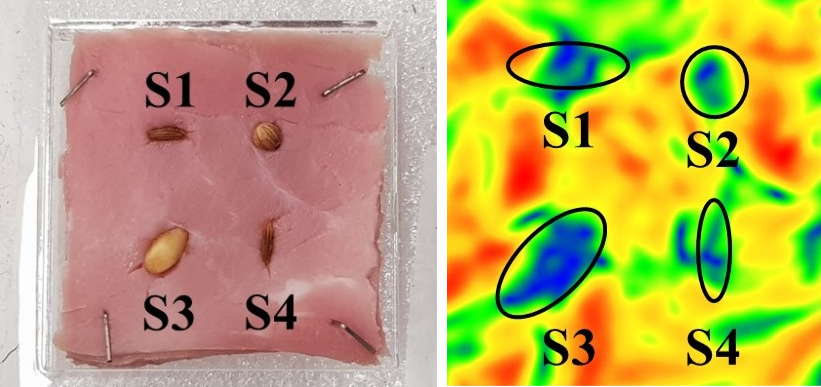
One of the most significant problems the Australian sheep and lamb industry faces today is grass seed infestation (GSI), which occurs when seeds accumulate in the sheep's fleece and penetrate the skin, causing infection. Meat and Livestock Australia estimates that the yearly losses caused due to GSI are around AUD47.5 M (in Australia alone). Here, we demonstrate that terahertz spectroscopy and imaging can be utilized for early detection of GSI. This is possible because terahertz waves can penetrate through sheep wool and have the appropriate wavelength for identifying the seed. Moreover, terahertz waves have non-invasive and non-ionizing properties and are ideal for non-contact and standoff detection. This work demonstrates that terahertz waves can be utilized for the early detection of seeds in the animal fleece or on the pelt as a precursor tool for the prevention of GSI.
Project Team: Dr Amus Goay, Mr Qigejian Alfred Wang, Dr Deepak Mishra, Dr Shaghik Atakaramians from UNSW, Dr Jane Kelly from Charls Sturt University, Dr Tomonori Hu, from NSSN, Alex Rizgalla, Jee Wei Tan, Suet Lee from Keysight
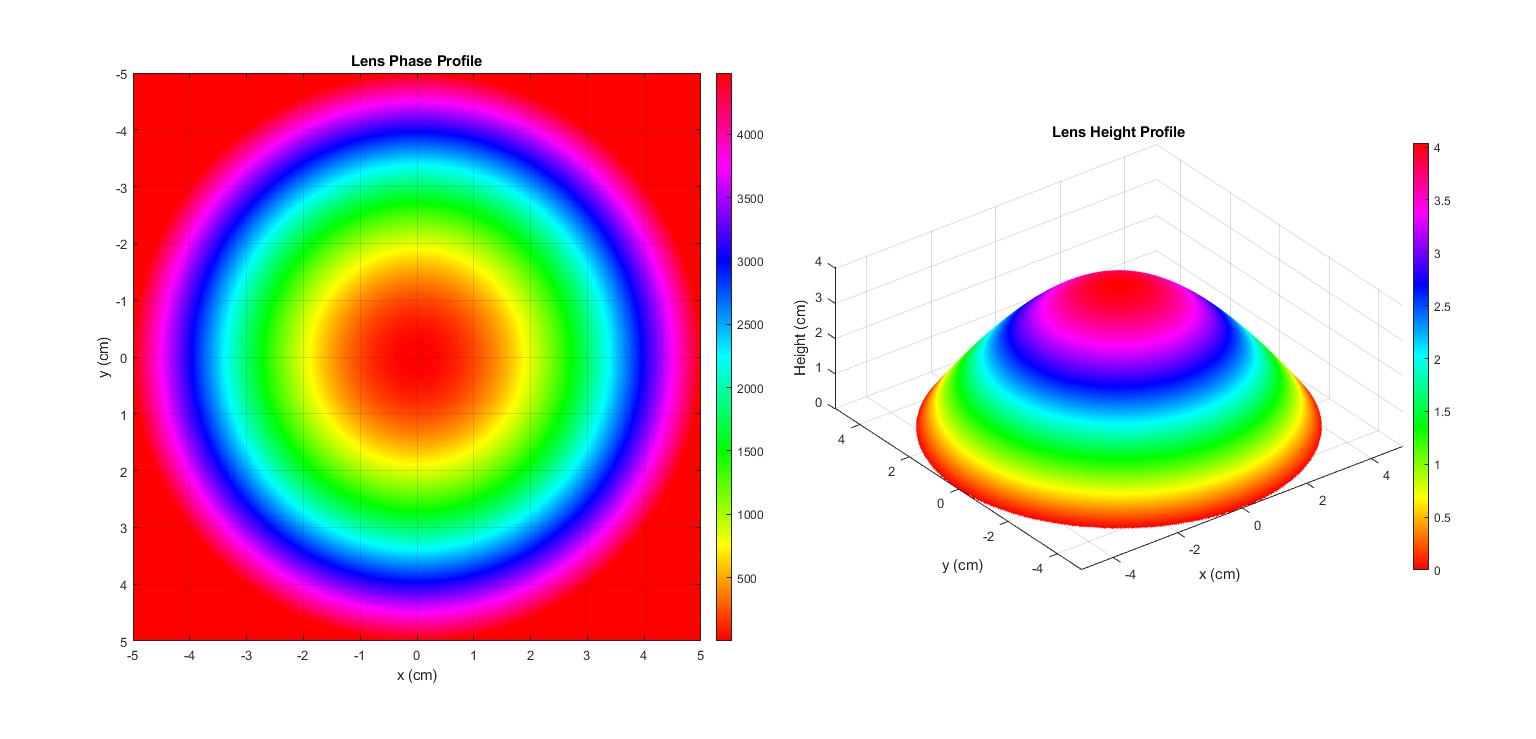
Designing terahertz optical elements is traditionally a complex and time-consuming process, often involving intricate calculations, extensive simulations, and carefully tailored structures. This project seeks to simplify and accelerate that workflow by developing an algorithm that automates the creation of 3D-printable lenses and waveplates. These devices can then be directly fabricated using 3D printing technology, paving the way for faster prototyping and broader accessibility in terahertz applications.
Project Team: Jeffrey Chandy, Runxiao Li, Housheng Che, Dr Dominik Vogt, Dr Wendy Lee from UNSW

Autonomous sensing and intelligent wireless tracking are becoming indispensable parts of human life. To realize them with a high level of accuracy, this project aims to design terahertz (THz) frequency smart antennas for spectrum-to-space mapping for backscattering-based localisation and identification. It is significant to move into the THz spectrum, the frontier of future wireless networks (5G and beyond), because the underlying wireless channel is more susceptible to finer changes. Novel backscattering designs to overcome the limitations of traditional position scanning techniques at THz frequencies are key outcomes of this project. Benefits include the provision of various national intelligence services for accurate wireless monitoring.
Project Team: Jing Kong, Mazen Abed, Dr Dominik Vogt, Dr Shaghik Atakaramians, Dr Deepak Mishra, Professor Aruna Seneviratne, and Professor Jinhong Yuan from UNSW

Indoor localisation systems often encounter challenges related to cost, power consumption, and environmental adaptability. To address these issues, this project investigates a passive metasurface-based solution operating within the Wi-Fi frequency band (5–6 GHz). Three metasurfaces were designed to operate at 5.2 GHz, 5.5 GHz, and 5.7 GHz, respectively, and were fabricated using standard PCB techniques.A dual metasurface configuration was proposed by placing two metasurfaces adjacent to each other. Experimental results demonstrated that the system produces distinct reflected wave patterns depending on the position of an obstacle, indicating its capability for spatial discrimination. To enhance angular detection, a trihedral corner reflector was integrated behind the metasurface. The fabricated tags were tested in a realistic, cluttered indoor environment. Results show that the metasurface-integrated trihedral corner reflector tag performs reliably under both normal and oblique incidence. Based on the received signal response, the system can effectively distinguish between entirely blocked, partially blocked, and unblocked scenarios, without relying on complex algorithms or external power sources.
Project Team: Xinyan Ren, Dr Deepak Mishra, Dr Shaghik Atakaramians, Dr Wendy Suk Ling Lee from University of New South Wales (UNSW) Sydney, Australia, Tianchang Ma from The University of Adelaide, Australia, and Dr Shengjian Jammy Chen from the Flinders University & The University of Adelaide, Australia
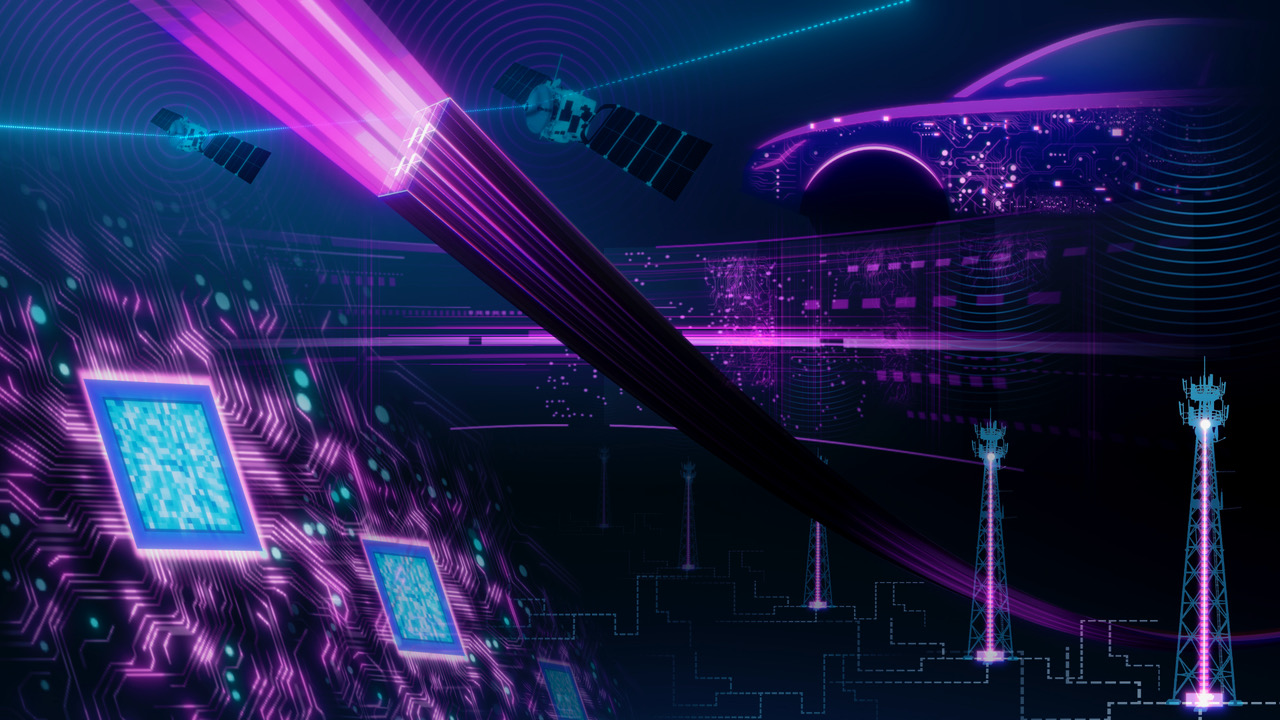
The rapid shift toward a data-driven society has intensified the demand for high-speed data transmission. The terahertz (THz) frequency band presents a promising solution for next-generation communication systems, offering significantly broader bandwidth than traditional copper-based links, which are increasingly constrained by bandwidth limitations. This project aims to develop a new class of polymer-based terahertz fibres to replace conventional lossy wiring. Our approach combines innovative microstructured fibre designs with cost-effective, scalable fabrication techniques, and seamless integration into future communication infrastructures. Leveraging low-loss Zeonex material, we are designing polymer interconnects with attenuation levels below 1 dB/m in the D-band, paving the way for efficient, high-performance THz data links.
Project Team: Mr Mengqin Gu, Mr Shehab Khan, Mr Qigejian Wang, Shaghik from UNSW, Mr Amit Halder, Prof Heike Ebendorff-Heidepriem from University of Adelaide, Dr Sining An and Dr Parisa Aghdam from Ercisson
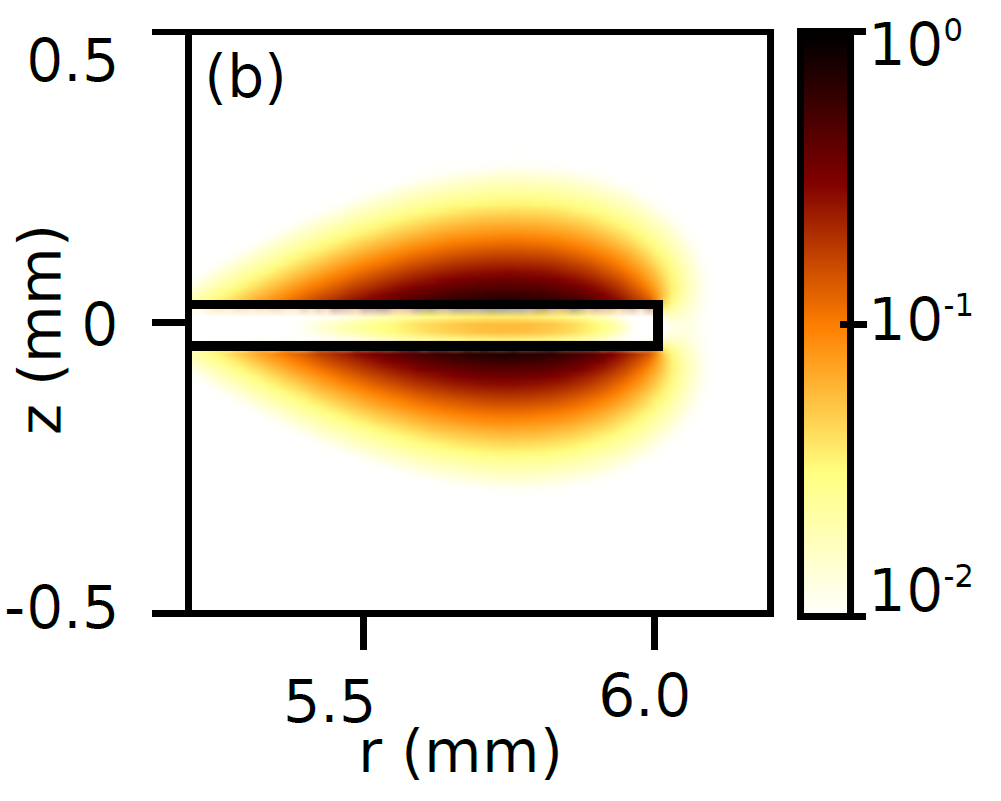
Subwavelength-thick ultrahigh-Q terahertz microresonators are pivotal for terahertz technologies, with applications ranging from multichannel upconversion to gas-phase spectroscopy. However, the resonant modes, which govern their unique behavior, are experimentally non-trivial to characterize and systematically classify. Here, we employ virtual superlens for near-field imaging to resolve these modes at subwavelength resolution.
Project Team: Boyuan Tian, Dr Dominik Vogt, Dr Shaghik Atakaramians from UNSW, and Dr Alessandro Tuniz from CSIRO
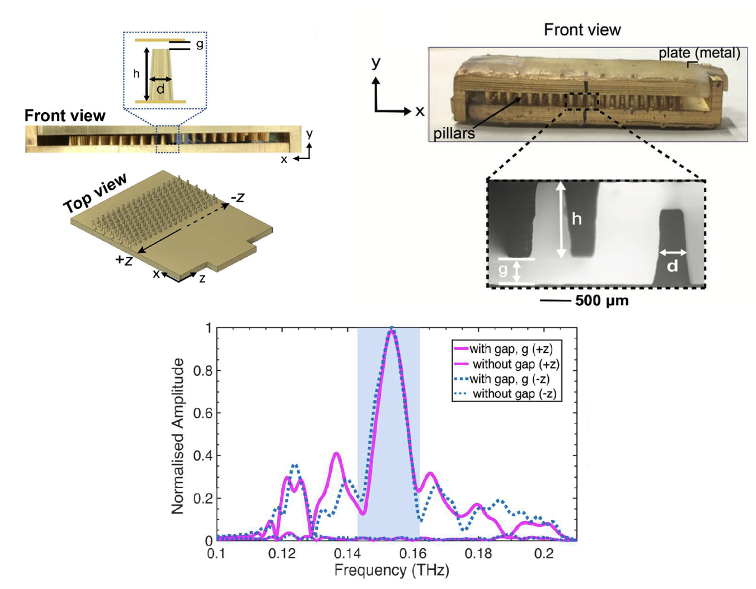
Compact and robust terahertz devices require low-cost and high bandwidth waveguiding technologies. Several approaches have been proposed including planar THz waveguides such as metallic parallel-plate waveguides and two-dimensional dielectric photonic crystal waveguides. However, the aforementioned conventional THz waveguides show narrow bandwidth due to losses at sharp bends and dispersion. To address this problem, photonic topological insulators, in which edge states of light are protected from defects and imperfections, rise up as an avenue to develop integrated THz waveguides exhibiting low-loss bends. Prior experiments on photonic topological waveguides have largely focused on optical and microwave frequencies. In this project, we develop an air-channel terahertz topological waveguide with wider relative bandwidth and low-cost fabrication. A low-cost 3D-printed topological waveguide is demonstrated that supports robust topological propagation along with broader topological bandwidth (relative bandwidth of ~12.5%) between 0.143–0.162 THz compared to the all-silicon topological THz waveguides (relative bandwidth of ~7.8%). The waveguide structure offers benefits including air-core guidance, mechanical reconfigurability and ease for fabrication as compared to only other silicon-based topological waveguides in the THz region. This work provides a promising path towards compact integrated devices as a next-generation frontier for advanced THs system.
Project Team: Mr Muhammad Talal Ali Khan, Mr Nathan Duong, Dr Shaghik Atakaramians from UNSW, Dr Haisu Li from Beijing Jiaotong University and Dr. Andrea Blanco-Redondo from Nokia Bell Labs, USA.
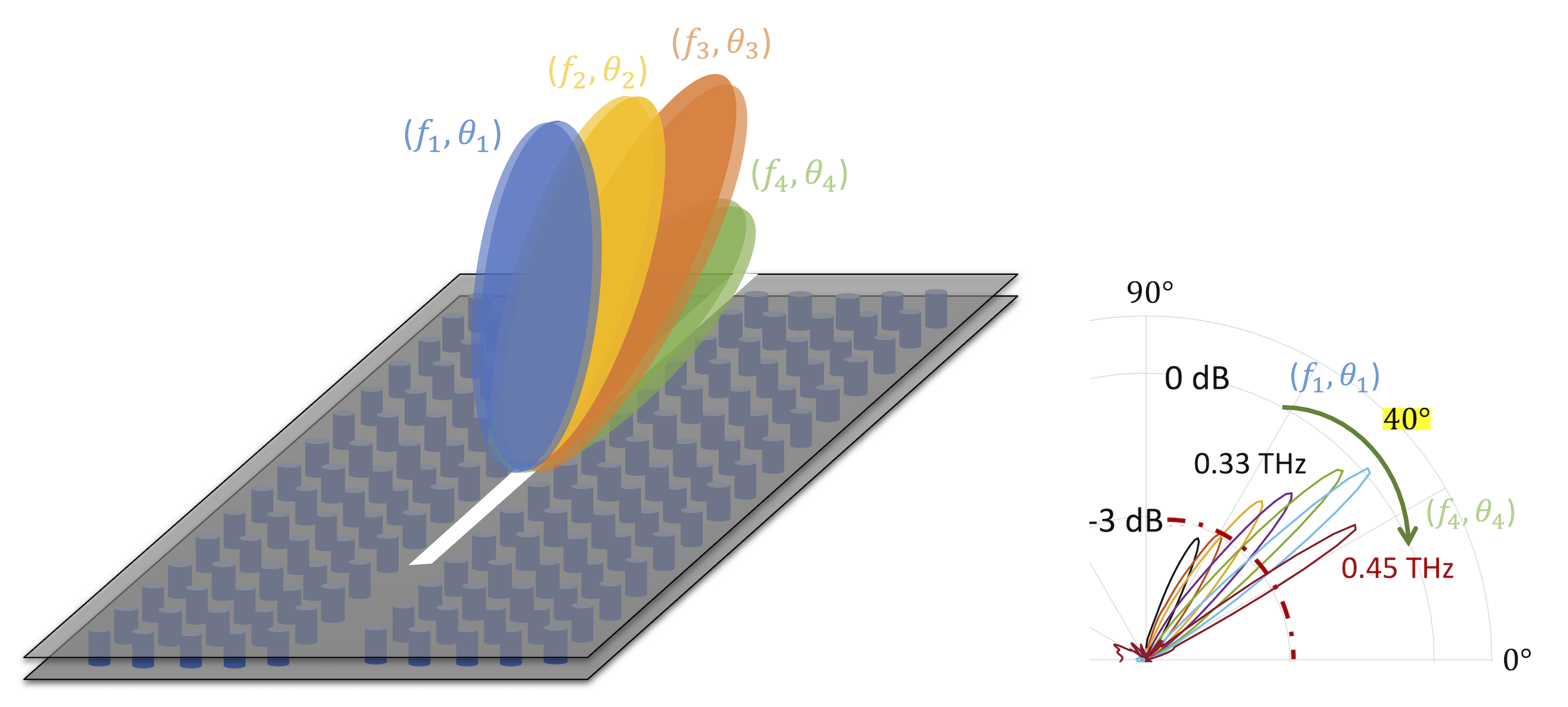
The research steps towards what will become 6G have already started. Radio frequencies beyond 100GHz, terahertz band, are being utilized to support ultra-wide bandwidth high-speed communication. Moving to higher frequency requires developing novel critical components such as modulators, multiplexers, and beam steerers. We have designed a hybrid photonic crystal leaky-wave antenna, which enables a spectrum-to-space mapping. This device has an over 100GHz bandwidth (0.33-0.45 THz) and maps the spectrum efficiently to different angular location within a 40° angle. The proposed device is easy to insstegrate and can be used for sensing and localizing multiple in a simultaneous and single-shot approach at terahertz frequencies.
Project Team: Ms Zetong Zhao, Mr Qigejian Wang, Dr Deepak Mishra and Dr Shaghik Atakaramians from UNSW, Dr Haisu Li and Ms Ruiyu Yin from Beijing Jiaotong University.
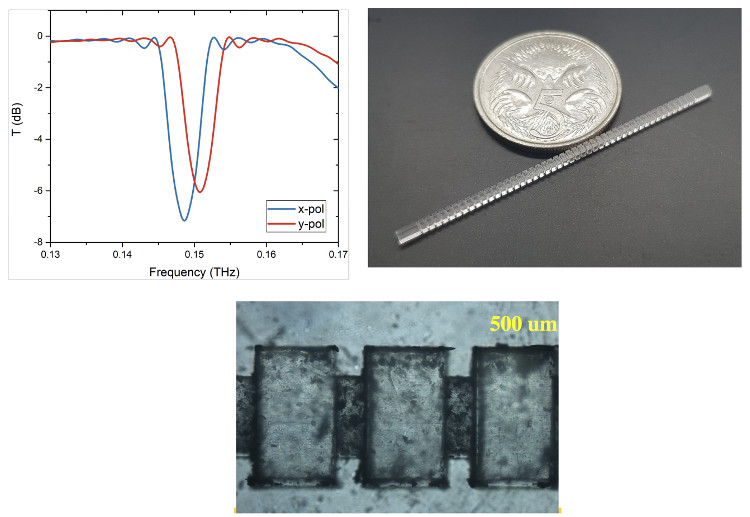
To achieve real-time signal processing for the terahertz communication systems, such as dispersion compensation and polarization manipulation, corresponding functional components based on terahertz waveguiding technology are in great demand. Inspired from the subwavelength polymer waveguide that supports mode propagating along the surface, we develop terahertz gratings filtering two orthogonally polarized states simultaneously. The fabrication of a THz birefringent polymer subwavelength fiber grating is performed using micromachining techniques in a low-loss polymer material, cyclic olefin copolymer. An important feature of the filter is the large negative dispersion. A compact terahertz polarization-maintaining subwavelength filter features large negative group velocity dispersion (over -188 ps/mm/THz) at around 0.15 THz. This large GVD shows 7.5 times increase in comparison of the state-of-the-art reported for THz in less than half of the length. This work can be a beneficial towards dispersion compensation and future fiber-based system integration of THz long-haul wireless or fiber-based links, in particular for satellite-assisted communication to maintain high transmission capacity.
Project Team: Mr Muhammad Talal Ali Khan, Prof. Gang-Ding Peng, Dr Shaghik Atakaramians from UNSW and Dr Haisu Li from Beijing Jiaotong University.
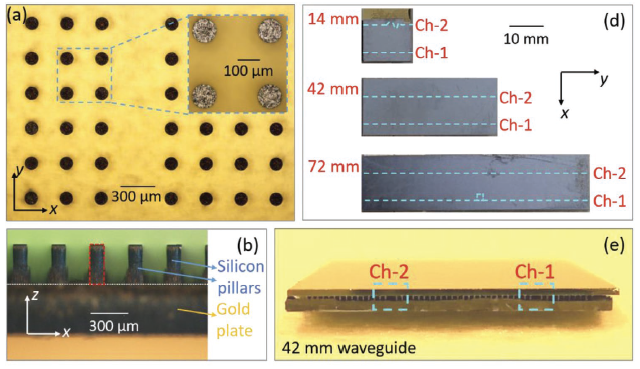
Conventional 2D photonic crystals (PCs) based terahertz waveguides are either all-metallic or all-dielectric, having either high propagation losses due to the Ohmic loss of metal, or a narrow transmission bandwidth restricted by the range of single-mode operation in a frequency range defined by the PC bandgap, respectively. To address this problem, we have developed a hybrid (metal/dielectric) terahertz waveguide chip, where the guided mode is completely confined by parallel gold plates and silicon PCs in vertical and lateral directions, respectively. A unique multiwafer silicon-based fabrication process, including gold–silicon eutectic bonding, micropatterning, and Bosch silicon etching, is employed to achieve the self-supporting hybrid structure. Theoretical and experimental investigations demonstrate that the hybrid waveguide supports a single-mode transmission covering 0.367–0.411 THz (bandwidth of 44 GHz, over twice wider than that of all-silicon PC waveguides) with low loss (below 0.05 dB/mm) and low group velocity dispersion (from −8.4 to −0.8 ps/THz/mm). This work enables more compact, wideband terahertz waveguides and auxiliary functional components that are integratable in chips toward ultra-high-density integrated terahertz devices in particular in the field of wireless communications.
Project Team: Dr Haisu Li from Beijing Jiaotong University, Dr Shaghik Atakaramians from UNSW, A/Prof Boris Kuhlmey from University of Sydney, A/Prof Withawat Withayachumnankul from University of Adelaide, Mei Xian Low, Dr Rajour Tanyi Ako, Prof Amdhu Bhaskaran, Prof Sharath Sriram from RMIT
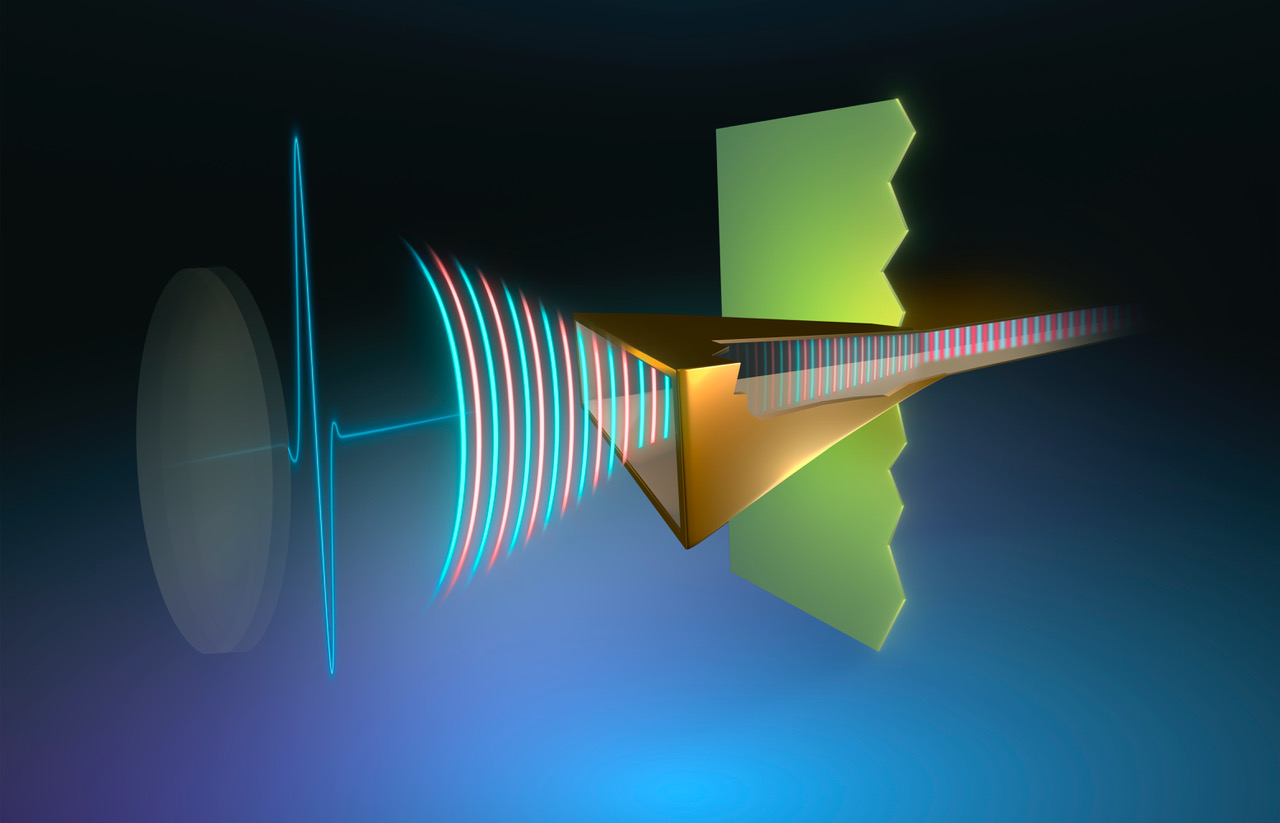
Terahertz band is envisaged to provide substantially higher capacity and much lower latency for wireless communications in contrast to microwave frequencies. Moving to higher frequencies comes with its own unique challenges to be addressed, such as poor coupling efficiency from free space into and out of planar air-core waveguides. Here, we propose a framework for rapid design and low-cost fabrication of terahertz horn couplers. The horn couplers are first designed by maximizing the field overlap integral on apex and aperture interfaces, then fabricated exploiting 3D printing technique, and finally sputtered with a thin layer of gold. Experimental demonstrations show that the proposed horn coupler improves the transmittance of a hybrid photonic crystal waveguide by 20 dB in comparison with the previous pinhole-based coupling configuration. This work provides a fast, convenient and economical approach for design and fabrication of customized couplers for any waveguide size, with a cost of only 5% of commercially available counterparts, and could be integrated in 3D-printed terahertz devices during fabrication.
Project Team: Mr Qigejian Wang and Dr Shaghik Atakaramians from UNSW, A/Prof Boris Kuhlmey from University of Sydney, Dr Haisu Li from Beijing Jiaotong University

Metasurfaces are planar metamaterials, usually composed of sub-wavelength structures, enabling the modification of the amplitude, phase, and polarization of the local light at sub-wavelength scale. Metasurfaces have been studied for controlling electromagnetic waves in the terahertz spectrum. Ohmic loss of metals at higher frequencies limits their applications, so high-index dielectric elements, which also exhibit resonances, have been exploited for developing metasurfaces. Single-layer metasurfaces that can operate both in transmission and reflection modes are highly desired. We experimentally demonstrate a single-layer terahertz dielectric metasurface consisting of an array of sub-wavelength fibers. This metasurface has a high transmission window and can behave like a terahertz magnetic or electric mirror due to the excitation of resonances in the fibers depending on polarization. Changing the excitation angle leads to the appearance of new resonances. By exploring the variation of resonances due to excitation of single, double or array of fibers, we show that individual element resonances can interact and lead to high transmission when arranged in an array. The proposed single-layer metasurface opens new opportunities to develop terahertz devices for wavefront engineering.
Project Team: Mr Qigejian Wang and Dr Shaghik Atakaramians from UNSW, A/Prof Shahraam Afshar from University of South Australia, Prof Heike Ebendorff-Heidepriem from University of Adelaide